Part 1: The Weird Geometry of the Internet
Part 3: If you liked Dwarf Fortress, you’ll love Twilight: Breaking Dawn
Example of Thematic Relationships
I received quite a few comments about the last article, most of which I haven’t approved, alternately lambasting or defending the TV Tropes community that makes up the site’s forum. While the peer-collaborative aspect of this project is central to its character, my examination of TV Tropes is strictly limited to the tropes, indices and works pages themselves, and doesn’t include any reference to authors and admins that create and edit the content. Not that I haven’t looked at this aspect of commons-based peer-collaborative sites before, it’s just that there’s more than enough looking at how the content pages form structures. As far as the forum content, I think there’s worse one could do than perform the same kind of study as this for a large, active forum. According to the TV Tropes admins there are “three main groups of people using the site: readers, socializers, and editors. The smallest group, by far, is editors. Less than 1% of the readers are editors. About 3% are socializers. Ninety six percent of our 400, 000 daily viewers only ever read pages.” But, at the risk of repeating myself, this particular dive into TV Tropes doesn’t directly examine the social aspect of the site, whether in the editing of content pages or in forum activity.
Which brings me to the spaghetti. As I pointed out in the last post, TV Tropes is rather small as far as number of content pages (only around 50,000) but very dense as far as links between them (over 3.4 million). To make things a bit more manageable, I’ve dropped out the works and indices so as to only examine the network shown by the trope-to-trope connections. Without the index-trope, index-work and work-trope connections, the network becomes an almost-pedestrian 850,000 or so links, and finally some macro-structures become visible.
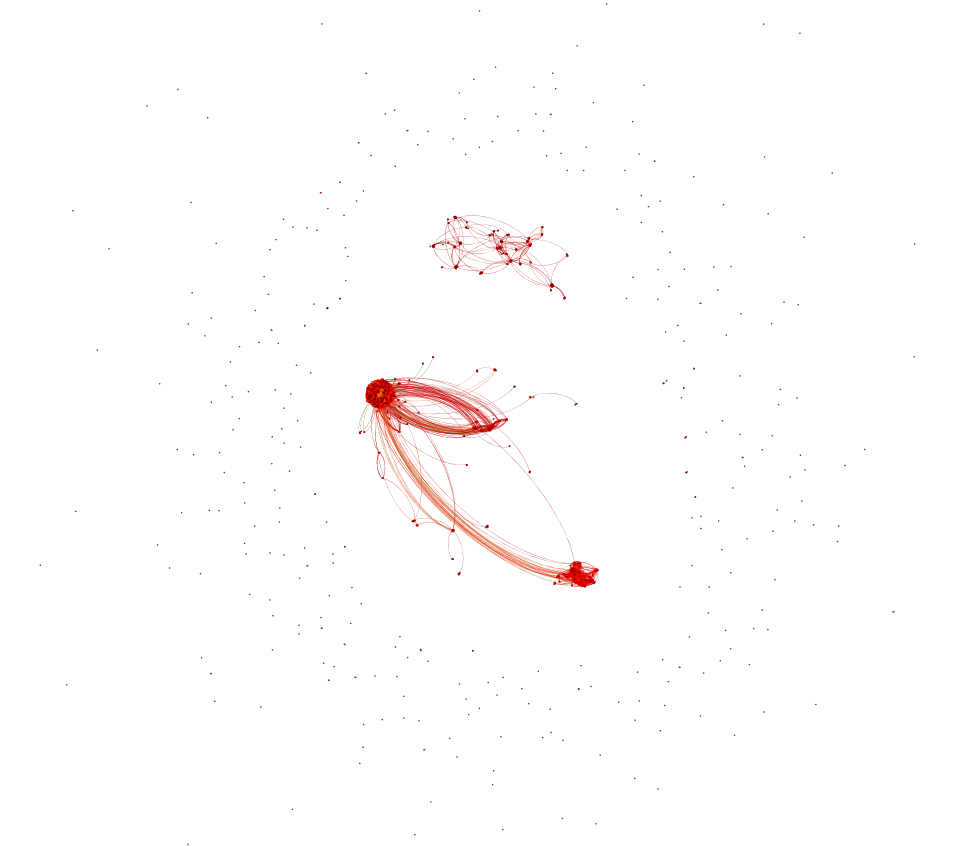
Just the tropes and their connections between each other. You can see two large components and a ring of disconnected orphan tropes.
Immediately visible is a scattered orbit of tropes that have little or no connection to other tropes. These are by turns unpopular, nascent and, based on their namespaces, foreign-language tropes. They show some variation in centrality because, of course, they’re still connected to works and perhaps indices but those connections have been dropped out.
The next discernible structure is actually the Hungarian TV Tropes, completely disconnected from the larger TV Tropes network. Now that there is only one type of content page being examined, tropes are colored by some attribute–in this initial case network centrality (directed Eigenvector centrality to be specific). Red is least central, through the color wheel to blue being most central. That centrality score was measured based off of the full network, including links to and from indices and works.
The nice thing about the Hungarian network is that it’s small and not so densely interlinked enough to actually look like a network as we would typically expect one. The same cannot be said for the remaining trope network.
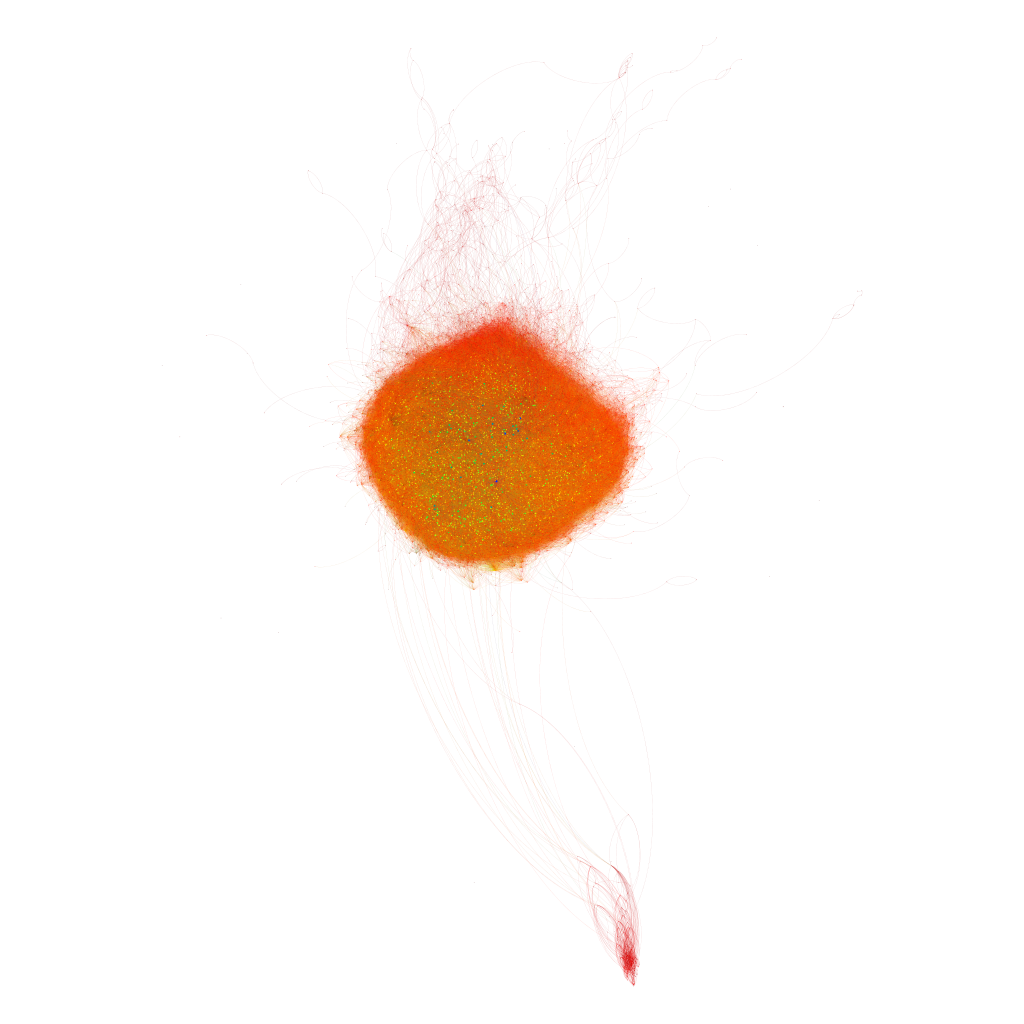 Consisting of a single, densely packed, core region and what I’ve been referring to as a “distant country” tenuously connected to that core, it makes it obvious why a picture is not necessarily worth 800,000 links. First, let’s answer the easy question: that distant country is the Italian TV Tropes, which has a few links from its tropes to other, more embedded tropes.
Consisting of a single, densely packed, core region and what I’ve been referring to as a “distant country” tenuously connected to that core, it makes it obvious why a picture is not necessarily worth 800,000 links. First, let’s answer the easy question: that distant country is the Italian TV Tropes, which has a few links from its tropes to other, more embedded tropes.
As a note, Hungarian and Italian (and for those with sharp eyes, Portuguese) are not the only foreign-language TV Tropes. Rather, they’re the most disconnected foreign language communities of any significant size. Spanish and German tropes have enough links into the larger network that they end up embedded within it visually (though they are distinct enough to be sheared off based on community detection).
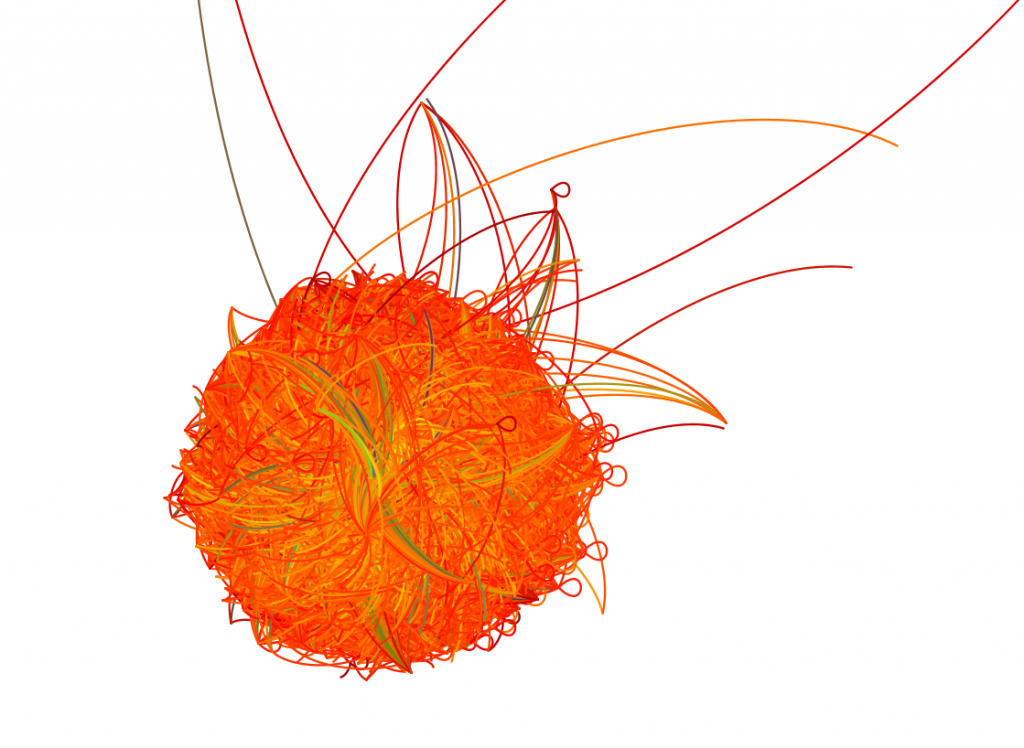 What that leaves me with seems only useful to kittens and knitters. As far as I know, there’s simply no good way to visually represent such a structure. And so, rather than look to visual methods to better understand TV Tropes, we turn to algorithmic ones. Modularity, something I touched on in a previous post, allows us to examine the network to see if there are particular communities of tropes that are more densely interconnected than than they are connected to the rest of the network.
What that leaves me with seems only useful to kittens and knitters. As far as I know, there’s simply no good way to visually represent such a structure. And so, rather than look to visual methods to better understand TV Tropes, we turn to algorithmic ones. Modularity, something I touched on in a previous post, allows us to examine the network to see if there are particular communities of tropes that are more densely interconnected than than they are connected to the rest of the network.
 The results are typically six regions of tropes. I mean typically, because community detection can return different results depending on how networks are interconnected. Again due to the number of connections between tropes, the regions discovered in this manner are considered weak (half the links are between communities and half are within communities) but they do tend to settle along six particular themes, though with some changes in membership depending on the random seed of the algorithm.
The results are typically six regions of tropes. I mean typically, because community detection can return different results depending on how networks are interconnected. Again due to the number of connections between tropes, the regions discovered in this manner are considered weak (half the links are between communities and half are within communities) but they do tend to settle along six particular themes, though with some changes in membership depending on the random seed of the algorithm.
These trope communities are named according to their most central trope, as well as with a vernacular description on my part to explain the pattern that I see. Each region includes an image of the tropes and connections that make it up, emphasizing their core/periphery structure (which is further evidenced by whether they occupy an edge of the network or, like the last neighborhood, are clustered in the center due to their high prevalence of links to other neighborhoods). Along with these images are links to a Google Spreadsheets listing the members and attributes of that community.
Neighborhood 1 – Word of God – “Dumbledore’s Secret”
Word of God Google Spreadsheet
A modern story is also a work and a community. The first region consists of tropes that focus on the interplay between creators, viewers and community. It includes tropes that involve story development over the course of a series (Retconning, Put on a Bus, Reset Button) as well as those that have to do with the method of storytelling (Flashback, Medium Awareness) and, most interestingly, interplay between the creators and the community.
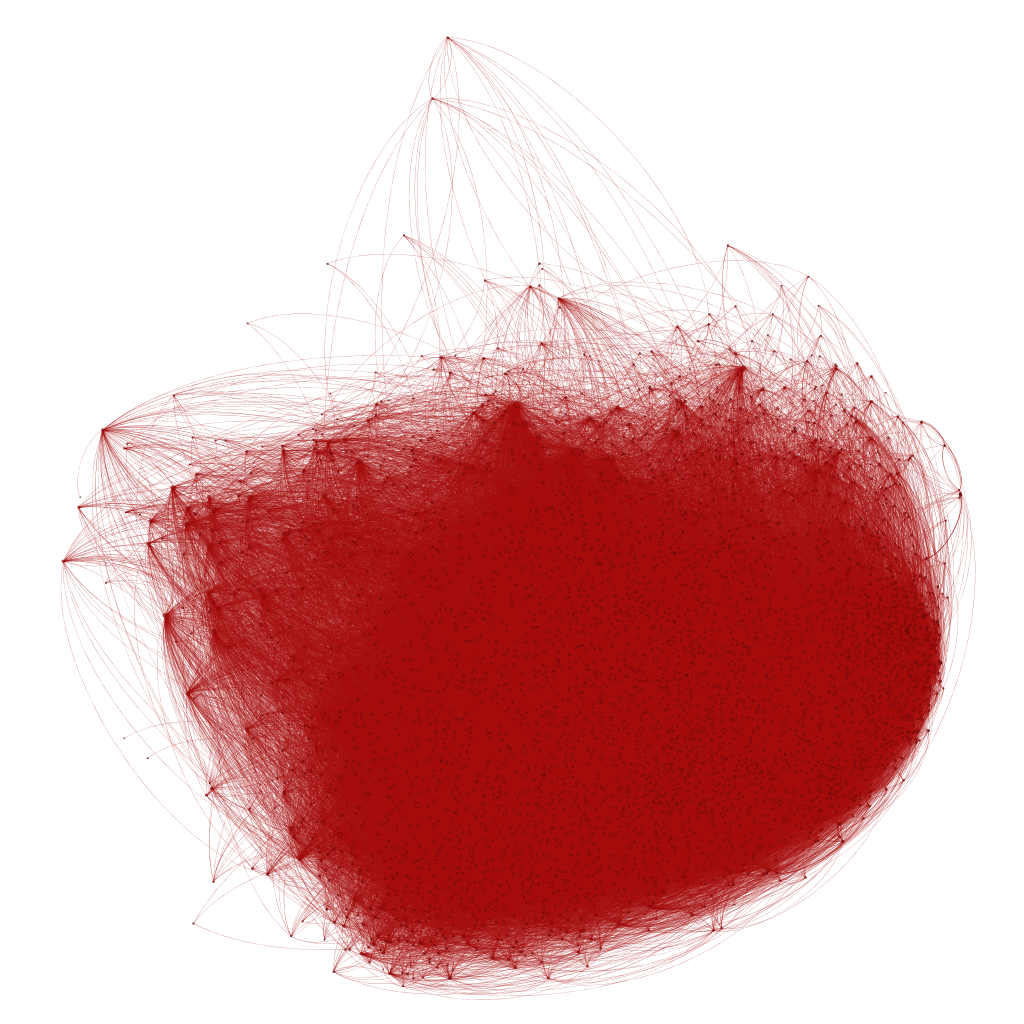
Neighborhood 2 – Big Bad – “Disney Characters and Motives”
This is, for the most part, populated by characters and actions by characters that have a more wholesome, simple, suburban or traditional feel to them. Heroes, villains, quests and the kinds of conflict and ends one would find in a Disney movie.
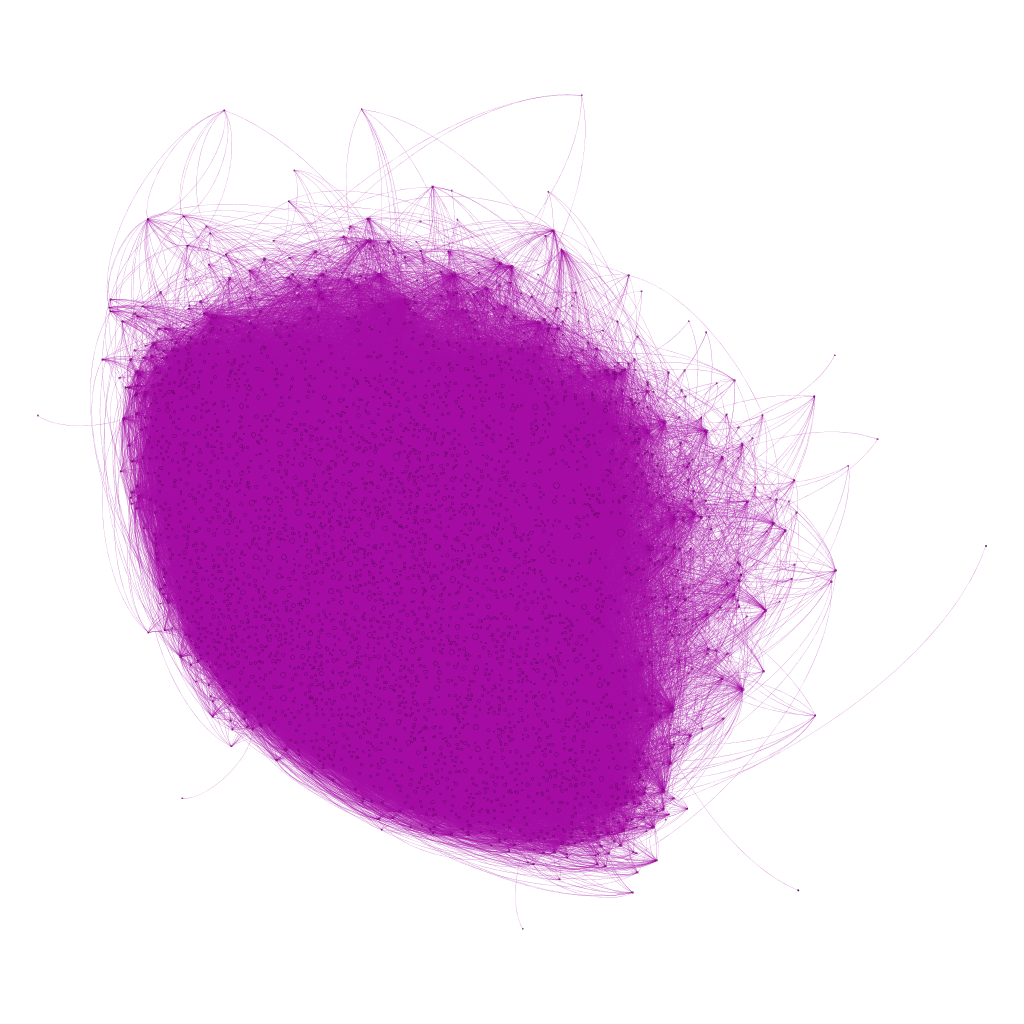
Neighborhood 3 – Berserk Button – “Dark Urges”
Berserk Button Google Spreadsheet
This was a hard one to name but is immediately recognizable. It’s everything that’s titillating, whether sexually or culturally or otherwise. It’s not just all the characters that emphasize sexual roles, but also emotional and psychological instability. The sort of greasy, Sundance, dark Anime version of Neighborhood 2.
 Neighborhood 4 – Exactly What It Says on the Tin – “Overcompensation”
Neighborhood 4 – Exactly What It Says on the Tin – “Overcompensation”
Exactly What It Says on the Tin Google Spreadsheet
This is a very item-oriented neighborhood and, as such, it’s very video-game inflected. The BFG is here and so are the Red Shirts that get blown away in games with BFGs (and also movies and books that have the same theme). Bosses and Dakka seem to cross over from their roots in video and wargaming and Chekhov’s Gun, at least insofar as this analysis seems to reveal, is more tangible than you’d think.
 Neighborhood 5 – Lampshade Hanging – “A Very TV Tropes Movie”
Neighborhood 5 – Lampshade Hanging – “A Very TV Tropes Movie”
Lampshade Hanging Google Spreadsheet
Here’s everything a writer can put into their work that self-consciously acknowledges it as a work being received by an audience well-versed in works. If you scroll down out of the really central tropes, you start to see things that really do fall into this definition, such as Giver of Lame Names.

Neighborhood 6 – Mad Scientist – “Monsters”
Mad Scientist Google Spreadsheet
This is really interesting to me. In TV Tropes, horror seems to be its very own region. It doesn’t make sense given the structural nature of the other regions but this—the smallest “community” in the tropes network—is supposed to be a genre. No other genres are represented, but it may be that horror is the most well-defined as far as tropes are concerned, or perhaps there’s a better reason that you all can give me.

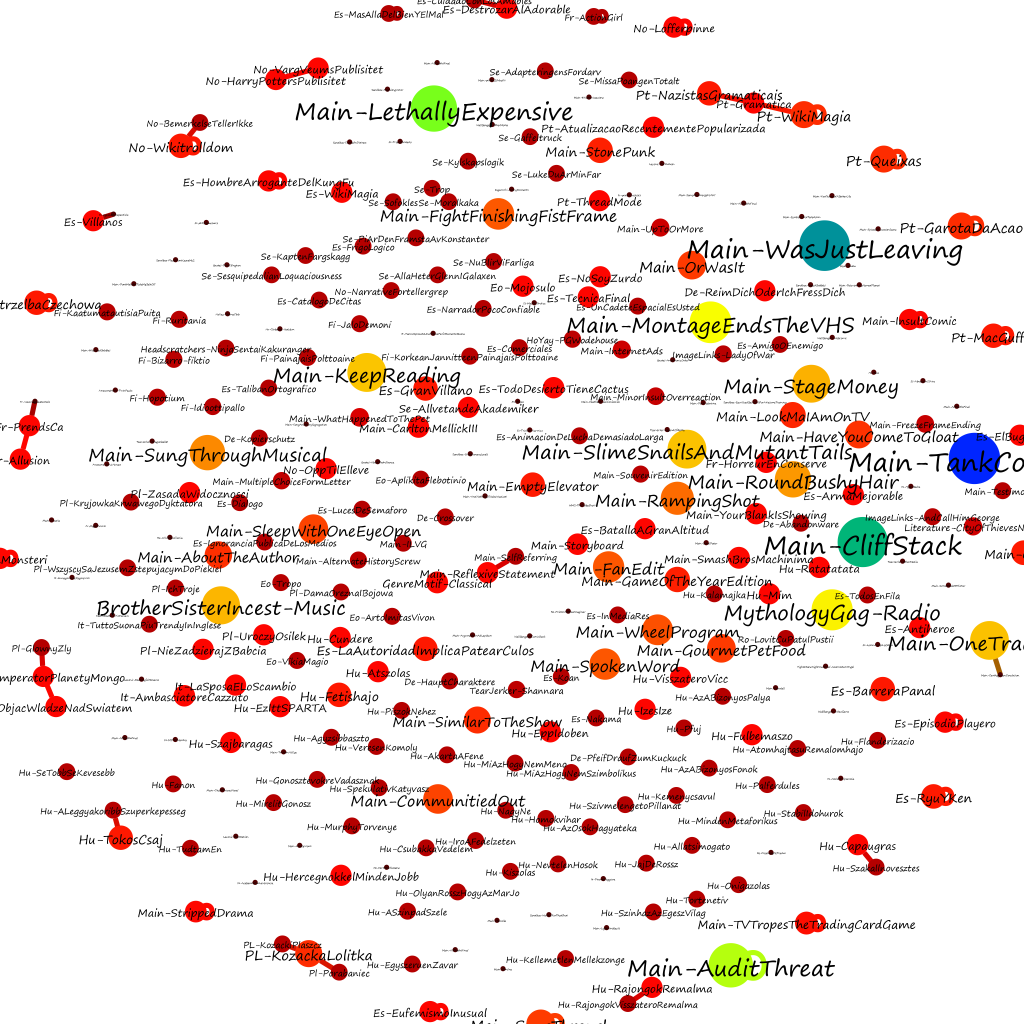
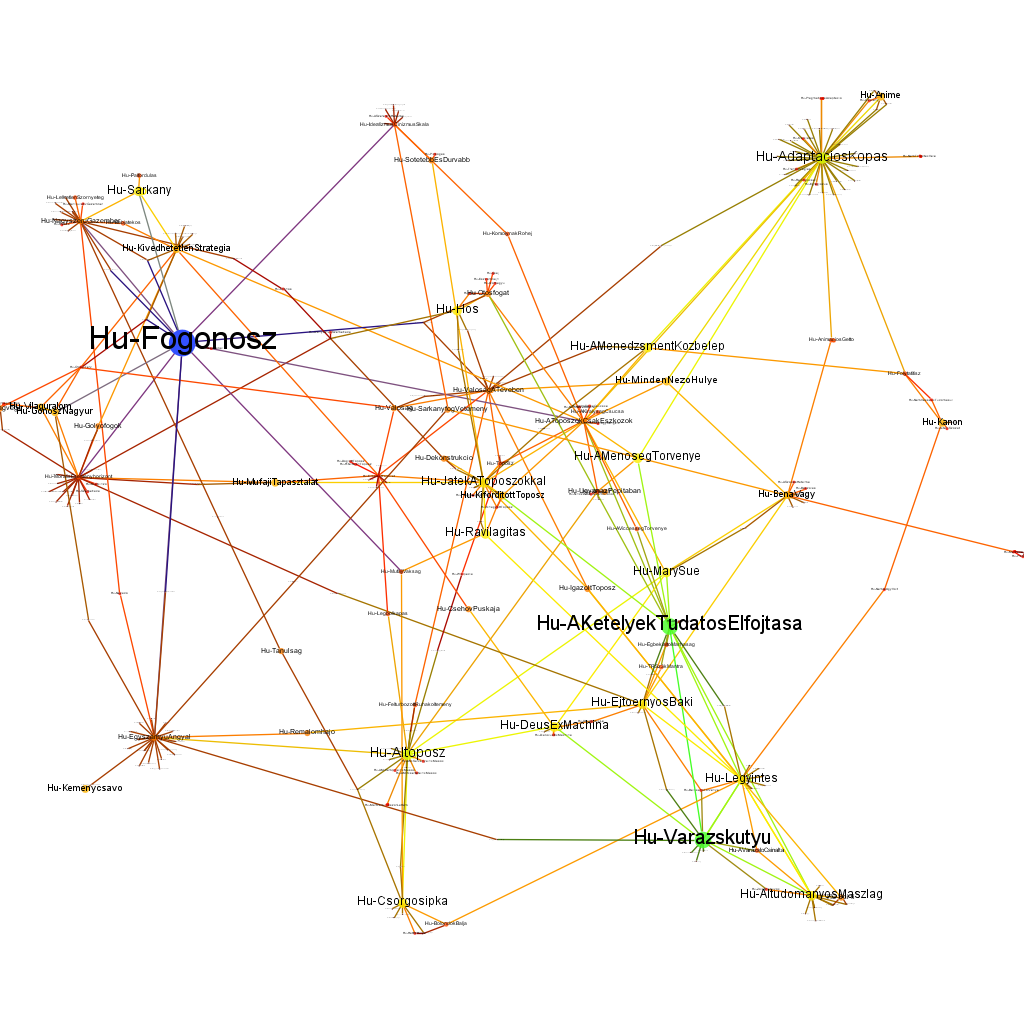
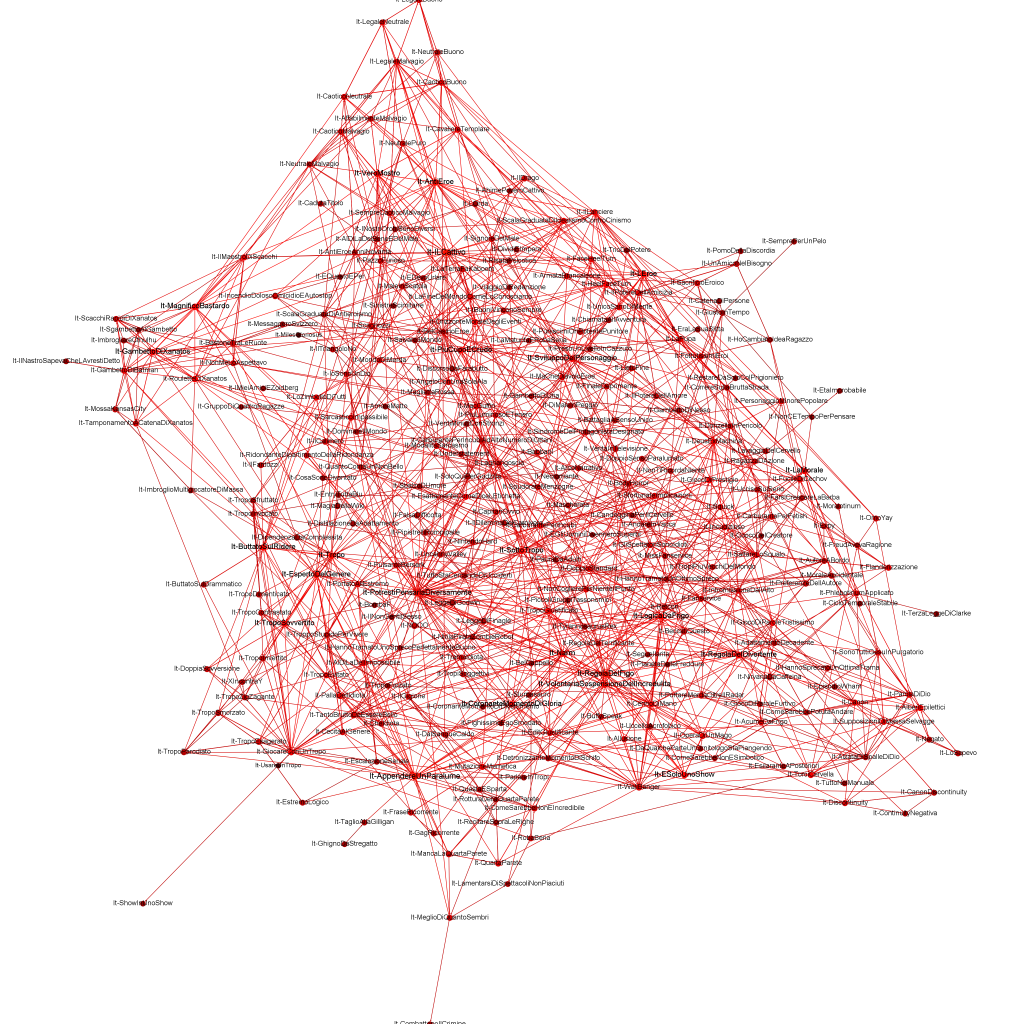

Looking at your spreadsheet for the “Horror” neighborhood, it strikes me more like the region would be more properly titled “The abnormal” or the “supernatural”. Yes, there are many horror tropes, but many of the tropes also deal with specific creatures, or specific abnormal traits/deformity a character may have. Many of the tropes listed there deal with non-standard physical attributes and appearances.
And this would explain the ties to horror and fear related articles like “Nightmare Fuel” – often what’s abnormal or different can be scary.
Splitting hairs is what genre criticism is all about, but I have to agree with Harbec that “horror” is the wrong word for the 6th neighborhood. Even the Scream series is too “meta” to really be about being scared, and most of the tropes are freak Bildungsroman. Buffy is a great example. This show is not about fear but evil provides the incentive for kids to stick together while they come of age.
At some point, Buffy says, “In all of this world, there’s only one thing that’s stronger than evil.” Then she pauses and says, “That’s us.”. This is what Ira Glass and many others like about the show: the good reason to stick together and be good.
Similarly,Vampires are about sexual opportunism, not frightening undead. This neighborhood is like Halloween, where we feel good about death and collect action figures of the occult. “It’s a Wonderful Death!”
I’d like to thank you for the diagram “tropes not connected or barely connected to other tropes.” A number of those tropes look like they need to be brought up in the forums (either to improve, or to cut.)